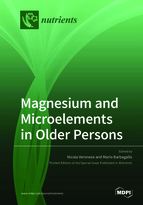Magnesium and Microelements in Older Persons
A special issue of Nutrients (ISSN 2072-6643). This special issue belongs to the section "Micronutrients and Human Health".
Deadline for manuscript submissions: closed (30 September 2020) | Viewed by 58481
Special Issue Editors
Interests: nutrition; epidemiology; older people; magnesium
Special Issues, Collections and Topics in MDPI journals
Interests: Mediterranean diet; aging; diabetes; hypertension; dementia; magnesium
Special Issues, Collections and Topics in MDPI journals
Special Issue Information
Dear Colleagues,
In this Special Issue, Prof. Mario Barbagallo and I would like to invite you to submit a paper regarding microelements and health status in older people. It is globally accepted that older people suffer from macro- and micronutrient deficiencies. This is often due to the high prevalence of malnutrition that is unfortunately associated with advancing age.
The limited introduction of microelements seems to be associated with a wide spectrum of medical conditions that are common in older people, especially metabolic and cardiovascular diseases, dementia, frailty, sarcopenia and, finally, mortality. However, the scientific literature regarding microelements deficiency in older people is still limited.
In our opinion, this Special Issue might offer readers the state-of-the-art regarding this important topic in order to better understand the clinical importance of microelements in older people.
Dr. Nicola Veronese
Prof. Mario Barbagallo
Guest Editors
Manuscript Submission Information
Manuscripts should be submitted online at www.mdpi.com by registering and logging in to this website. Once you are registered, click here to go to the submission form. Manuscripts can be submitted until the deadline. All submissions that pass pre-check are peer-reviewed. Accepted papers will be published continuously in the journal (as soon as accepted) and will be listed together on the special issue website. Research articles, review articles as well as short communications are invited. For planned papers, a title and short abstract (about 100 words) can be sent to the Editorial Office for announcement on this website.
Submitted manuscripts should not have been published previously, nor be under consideration for publication elsewhere (except conference proceedings papers). All manuscripts are thoroughly refereed through a single-blind peer-review process. A guide for authors and other relevant information for submission of manuscripts is available on the Instructions for Authors page. Nutrients is an international peer-reviewed open access semimonthly journal published by MDPI.
Please visit the Instructions for Authors page before submitting a manuscript. The Article Processing Charge (APC) for publication in this open access journal is 2900 CHF (Swiss Francs). Submitted papers should be well formatted and use good English. Authors may use MDPI's English editing service prior to publication or during author revisions.
Keywords
- microelements
- micronutrients
- malnutrition
- older people







